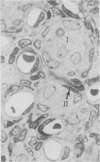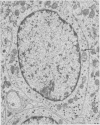Full text
PDF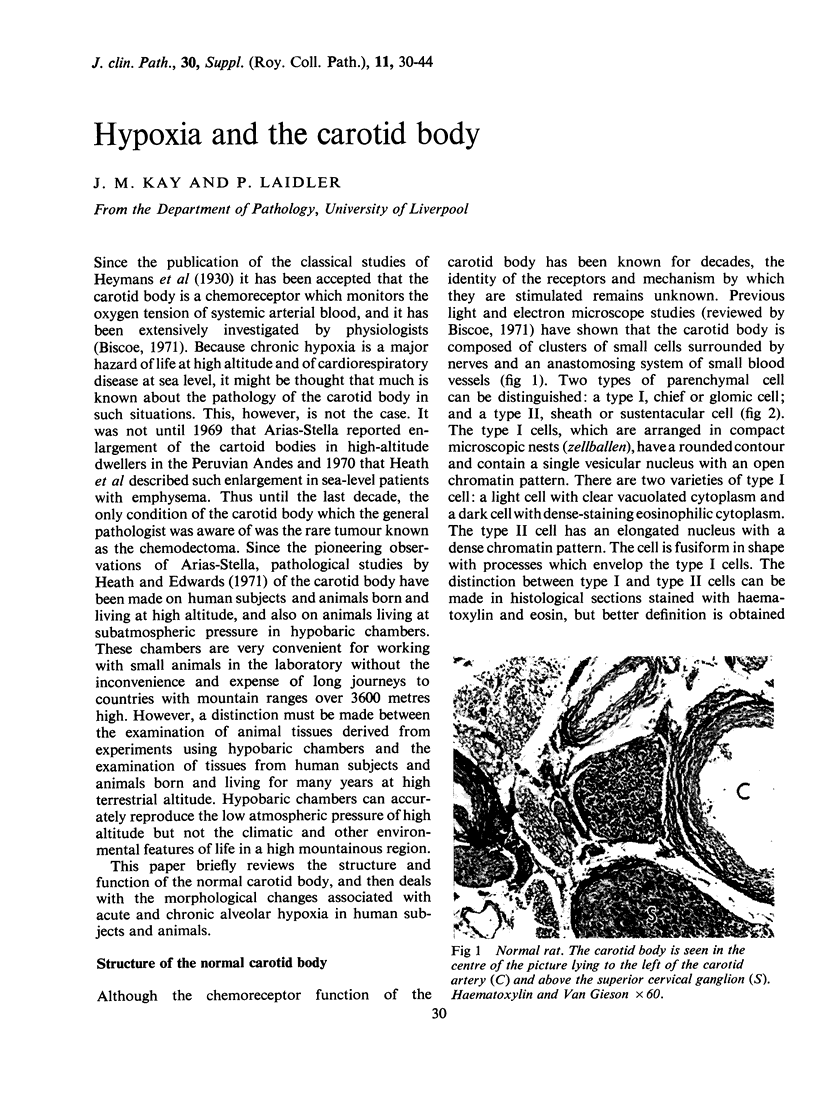
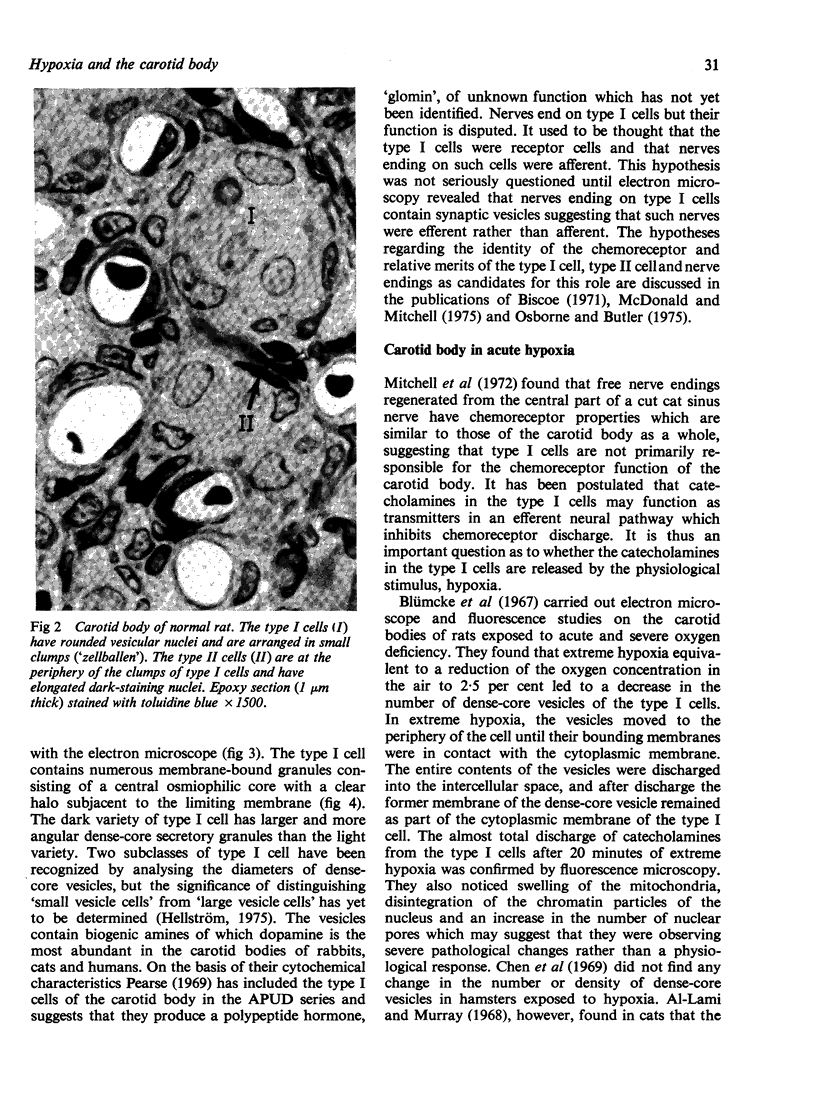
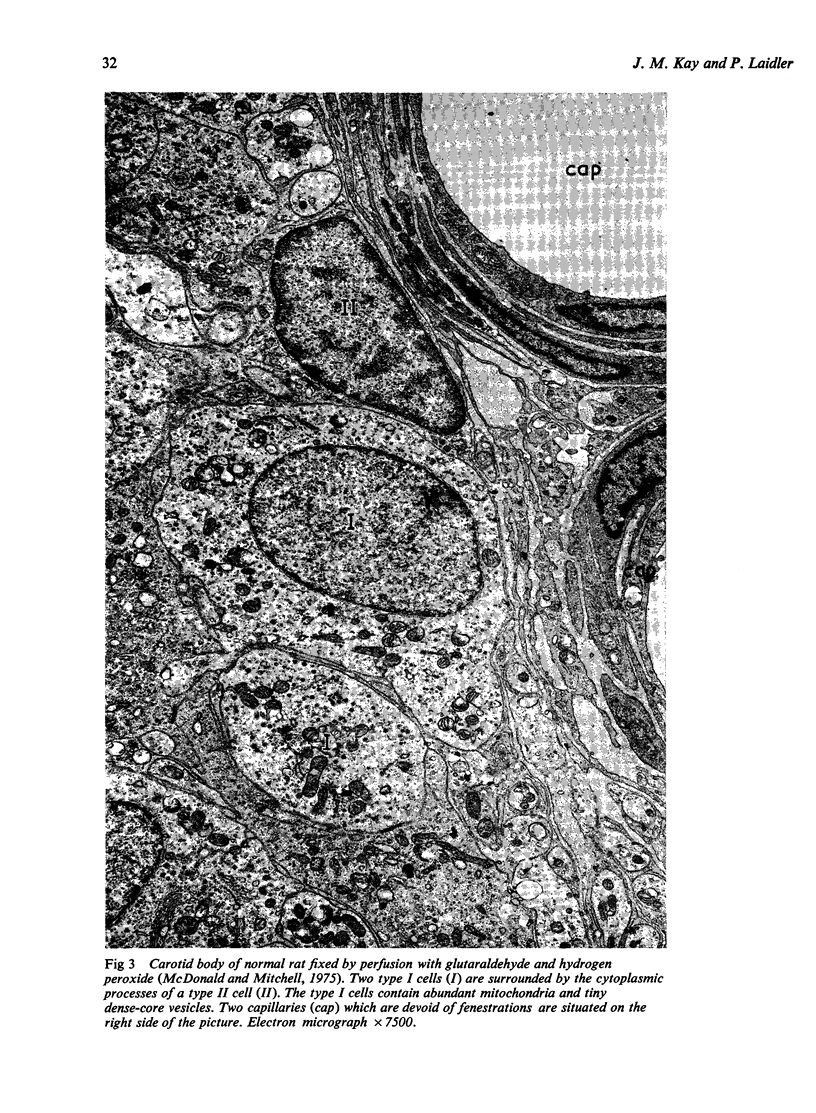


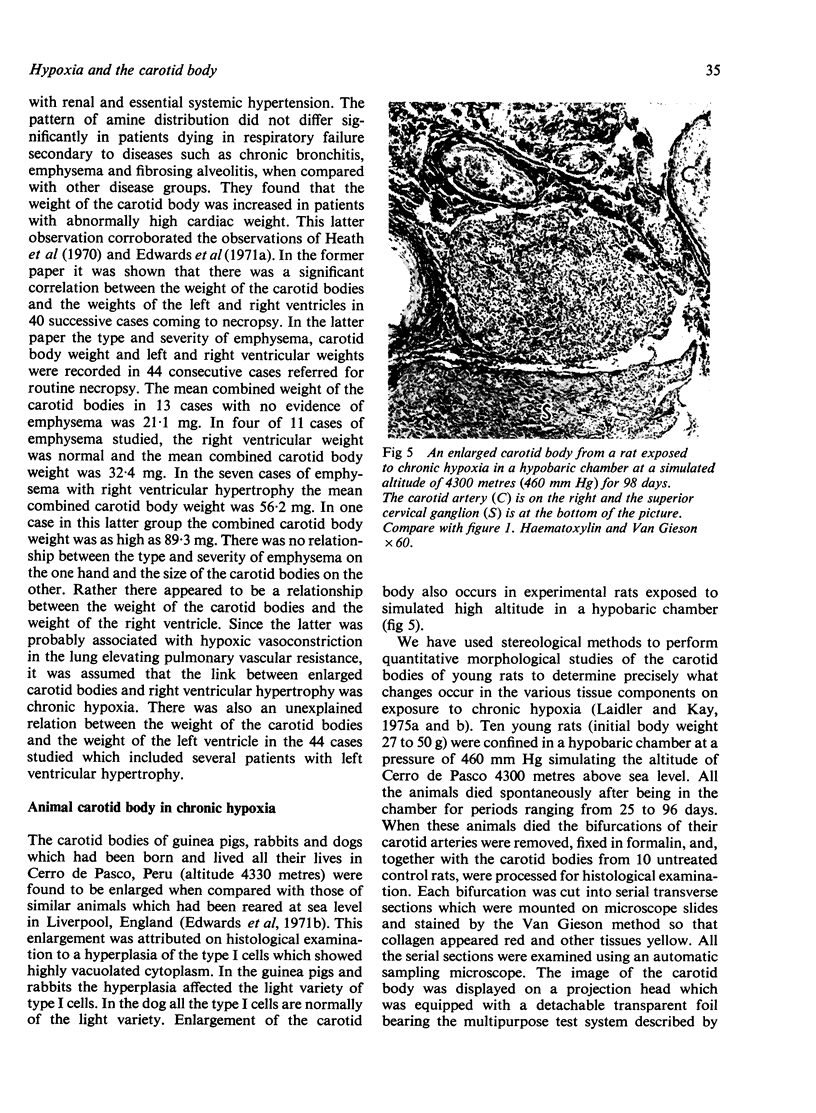
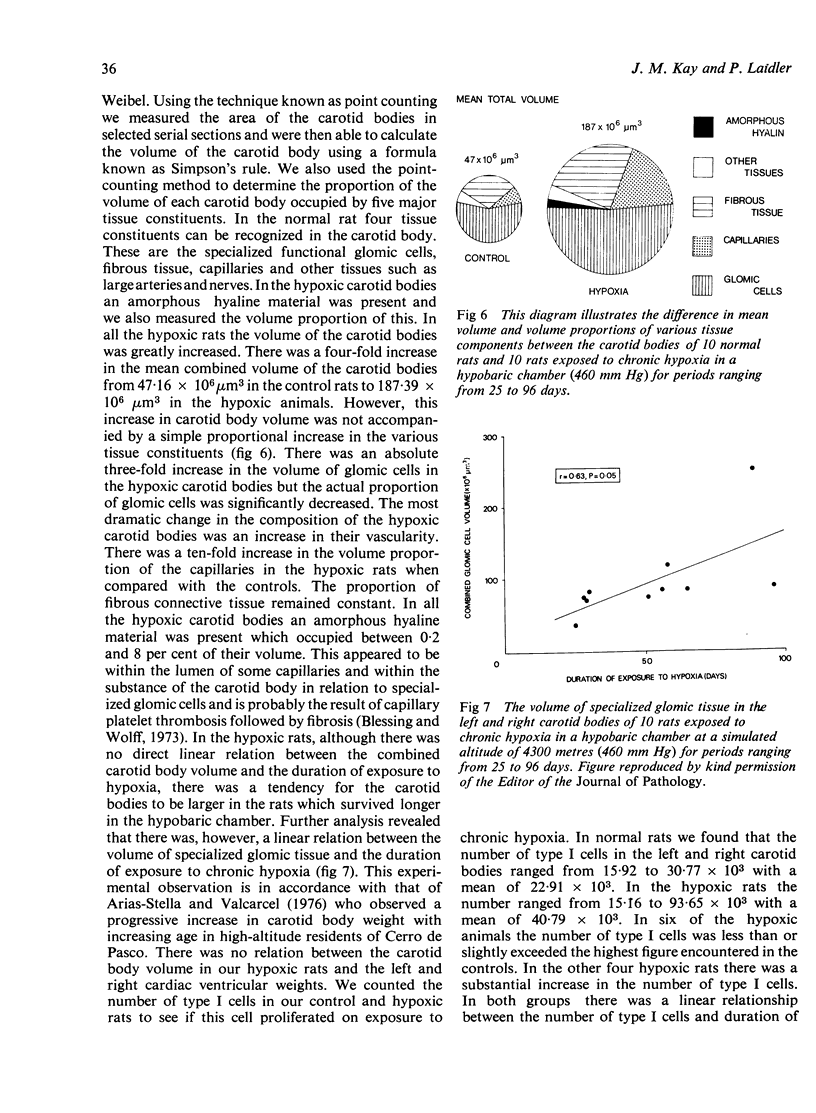
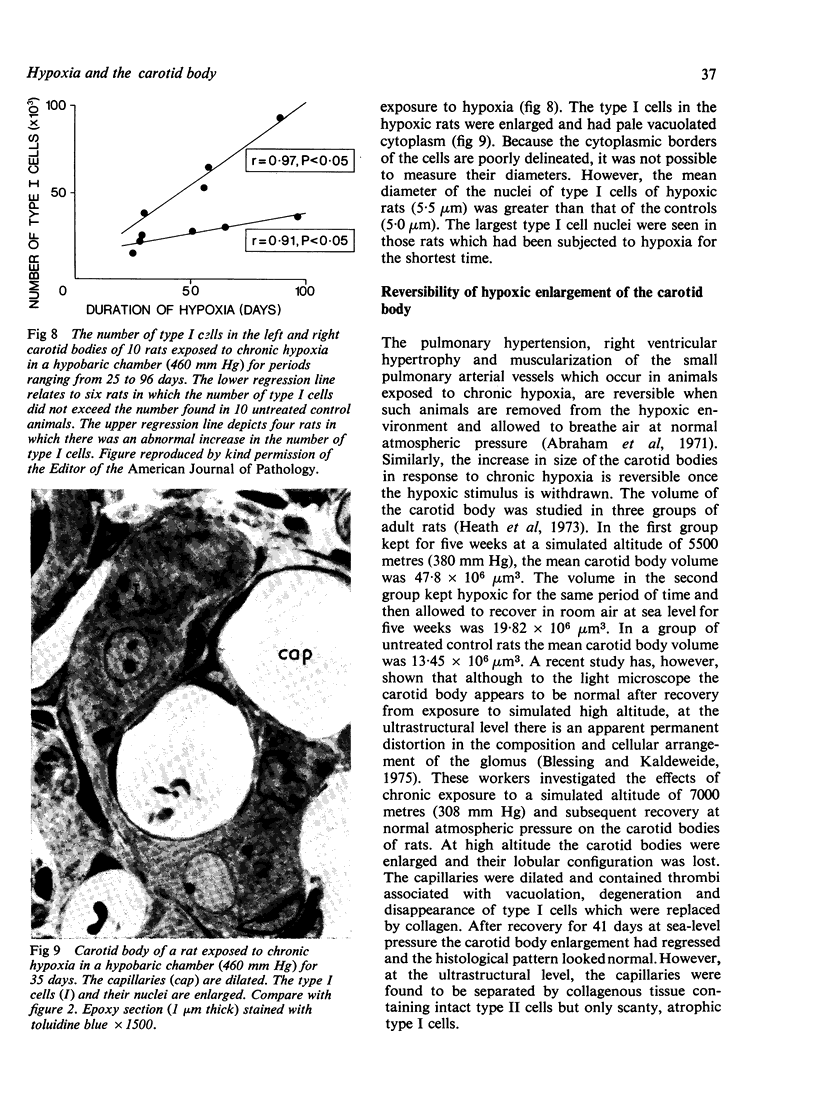

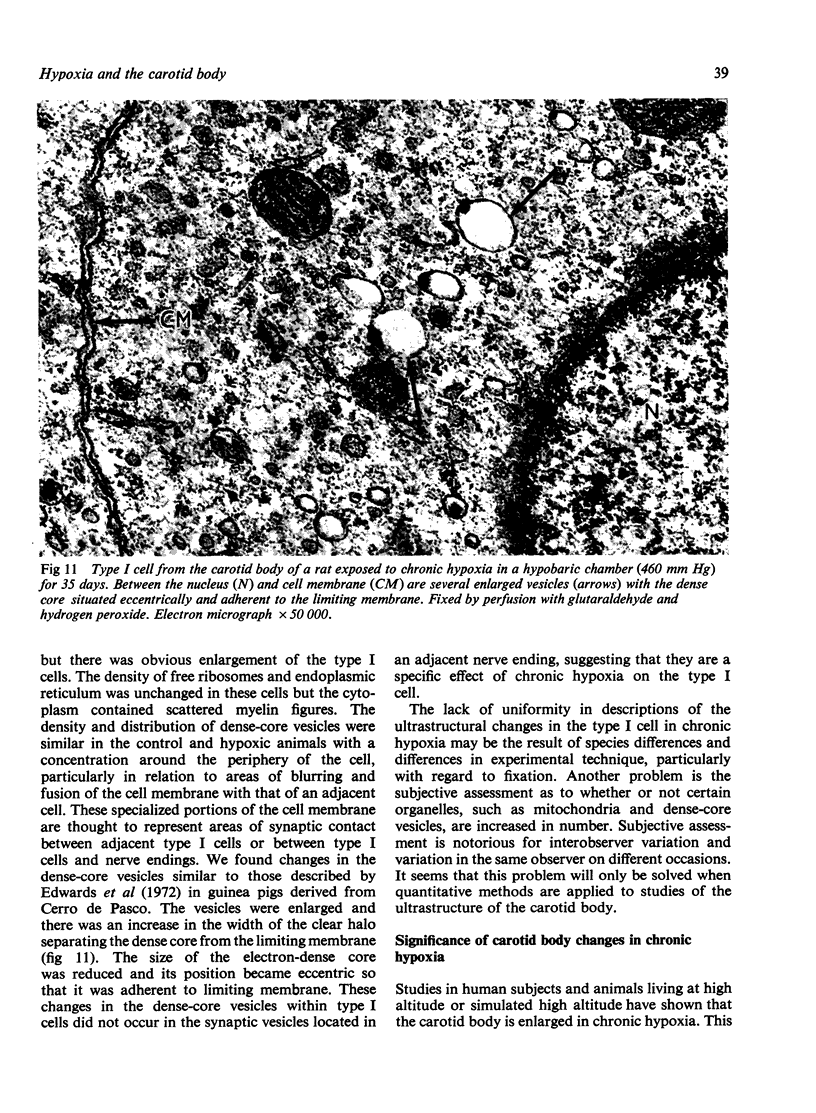
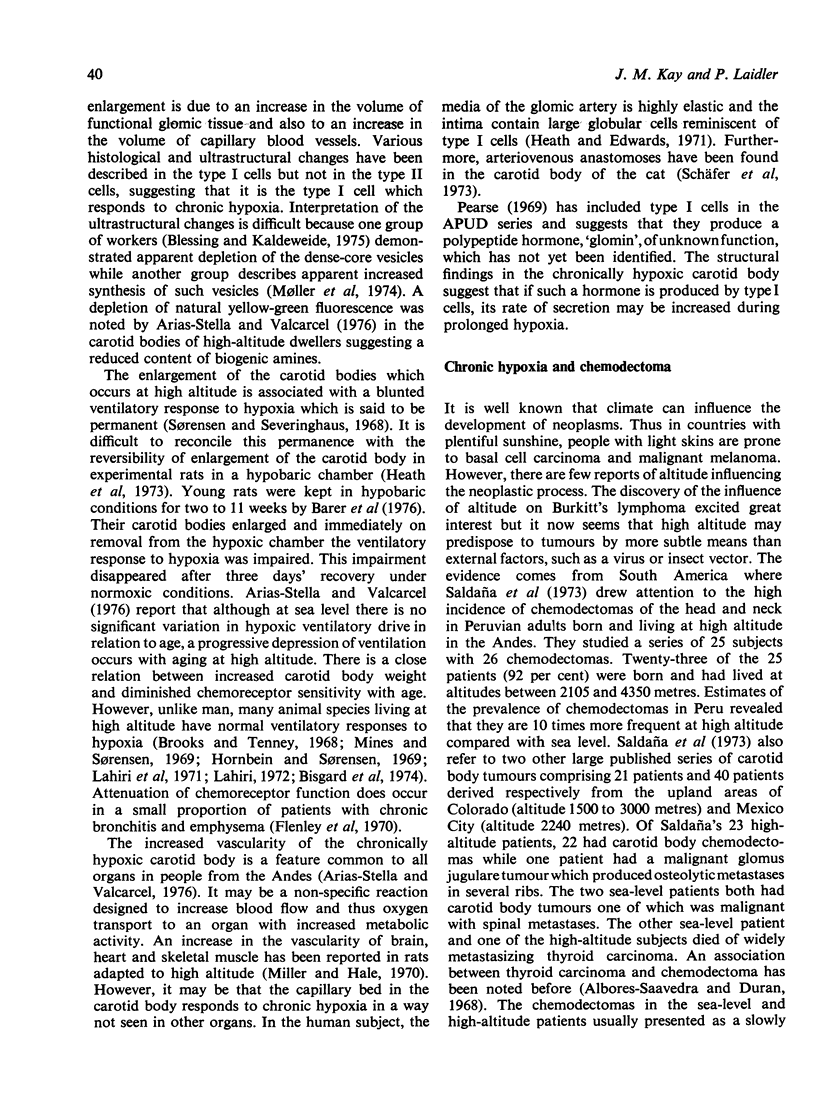


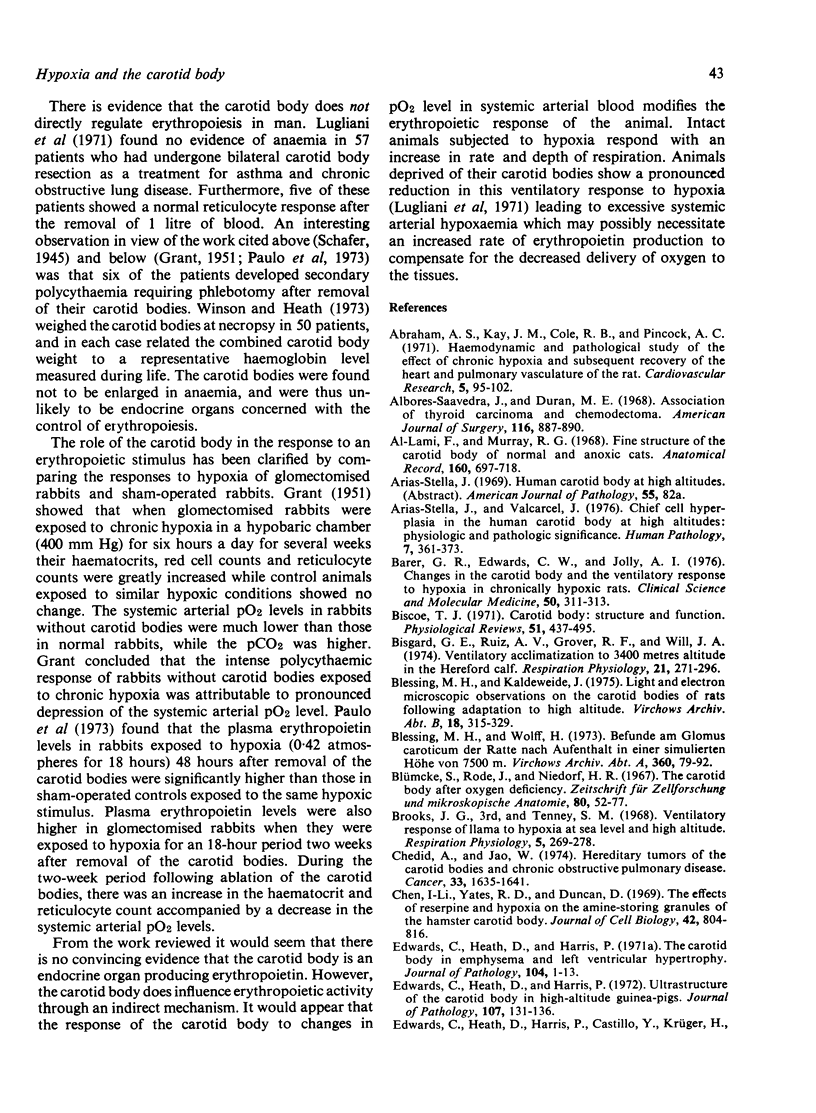

Images in this article
Selected References
These references are in PubMed. This may not be the complete list of references from this article.
- Abraham A. S., Kay J. M., Cole R. B., Pincock A. C. Haemodynamic and pathological study of the effect of chronic hypoxia and subsequent recovery of the heart and pulmonary vasculature of the rat. Cardiovasc Res. 1971 Jan;5(1):95–102. doi: 10.1093/cvr/5.1.95. [DOI] [PubMed] [Google Scholar]
- Albores-Saavedra J., Durán M. E. Association of thyroid carcinoma and chemodectoma. Am J Surg. 1968 Dec;116(6):887–890. doi: 10.1016/0002-9610(68)90460-1. [DOI] [PubMed] [Google Scholar]
- Arias-Stella J., Valcarcel J. Chief cell hyperplasia in the human carotid body at high altitudes; physiologic and pathologic significance. Hum Pathol. 1976 Jul;7(4):361–373. doi: 10.1016/s0046-8177(76)80052-4. [DOI] [PubMed] [Google Scholar]
- Barer G. R., Edwards C. W., Jolly A. I. Changes in the carotid body and the ventilatory response to hypoxia in chronically hypoxic rats. Clin Sci Mol Med. 1976 Apr;50(4):311–313. doi: 10.1042/cs0500311. [DOI] [PubMed] [Google Scholar]
- Biscoe T. J. Carotid body: structure and function. Physiol Rev. 1971 Jul;51(3):437–495. doi: 10.1152/physrev.1971.51.3.437. [DOI] [PubMed] [Google Scholar]
- Bisgard G. E., Ruiz A. V., Grover R. F., Will J. A. Ventilatory acclimatization to 3400 meters altitude in the Hereford calf. Respir Physiol. 1974 Sep;21(3):271–296. doi: 10.1016/0034-5687(74)90059-0. [DOI] [PubMed] [Google Scholar]
- Blessing M. H., Kaldeweide J. Light and electron microscopic observations on the carotid bodies of rats following adaptation to high altitude. Virchows Arch B Cell Pathol. 1975 Sep 11;18(4):315–329. doi: 10.1007/BF02889258. [DOI] [PubMed] [Google Scholar]
- Blessing M. H., Wolff H. Befunde am Glomus caroticum der Ratte nach Aufenthalt in einer simulierten Höhe von 7500 m. Virchows Arch A Pathol Pathol Anat. 1973;360(1):79–92. [PubMed] [Google Scholar]
- Blümcke S., Rode J., Niedorf H. R. The carotid body after oxygen deficiency. Z Zellforsch Mikrosk Anat. 1967;80(1):52–77. doi: 10.1007/BF00331477. [DOI] [PubMed] [Google Scholar]
- Brooks J. G., 3rd, Tenney S. M. Ventilatory response of llama to hypoxia at sea level and high altitude. Respir Physiol. 1968 Sep;5(2):269–278. doi: 10.1016/0034-5687(68)90065-0. [DOI] [PubMed] [Google Scholar]
- Chedid A., Jao W. Hereditary tumors of the carotid bodies and chronic obstructive pulmonary disease. Cancer. 1974 Jun;33(6):1635–1641. doi: 10.1002/1097-0142(197406)33:6<1635::aid-cncr2820330625>3.0.co;2-j. [DOI] [PubMed] [Google Scholar]
- Edwards C., Heath D., Harris P., Castillo Y., Krüger H., Arias-Stella J. The carotid body in animals at high altitude. J Pathol. 1971 Aug;104(4):231–238. doi: 10.1002/path.1711040404. [DOI] [PubMed] [Google Scholar]
- Edwards C., Heath D., Harris P. The carotid body in emphysema and left ventricular hypertrophy. J Pathol. 1971 May;104(1):1–13. doi: 10.1002/path.1711040102. [DOI] [PubMed] [Google Scholar]
- Edwards C., Heath D., Harris P. Ultrastructure of the carotid body in high-altitude guinea-pigs. J Pathol. 1972 Jun;107(2):131–136. doi: 10.1002/path.1711070209. [DOI] [PubMed] [Google Scholar]
- Flenley D. C., Franklin D. H., Millar J. S. The hypoxic drive to breathing in chronic bronchitis and emphysema. Clin Sci. 1970 Apr;38(4):503–518. doi: 10.1042/cs0380503. [DOI] [PubMed] [Google Scholar]
- GRANT W. C. Influence of carotid body removal on polycythemia and arterial oxygen saturation during discontinuous anoxia. Am J Physiol. 1951 Jan;164(1):226–233. doi: 10.1152/ajplegacy.1950.164.1.226. [DOI] [PubMed] [Google Scholar]
- Heath D., Edwards C., Harris P. Post-mortem size and structure of the human carotid body. Thorax. 1970 Mar;25(2):129–140. doi: 10.1136/thx.25.2.129. [DOI] [PMC free article] [PubMed] [Google Scholar]
- Heath D., Edwards C. The glomic arteries. Cardiovasc Res. 1971 Jul;5(3):303–312. doi: 10.1093/cvr/5.3.303. [DOI] [PubMed] [Google Scholar]
- Heath D., Edwards C., Winson M., Smith P. Effects on the right ventricle, pulmonary vasculature, and carotid bodies of the rat of exposure to, and recovery from, simulated high altitude. Thorax. 1973 Jan;28(1):24–28. doi: 10.1136/thx.28.1.24. [DOI] [PMC free article] [PubMed] [Google Scholar]
- Hellström S. Morphometric studies of dense-cored vesicles in type I cells of rat carotid body. J Neurocytol. 1975 Feb;4(1):77–86. doi: 10.1007/BF01099097. [DOI] [PubMed] [Google Scholar]
- Hornbein T. F., Sorensen S. C. Ventilatory response to hypoxia and hypercapnia in cats living at high altitude. J Appl Physiol. 1969 Dec;27(6):834–836. doi: 10.1152/jappl.1969.27.6.834. [DOI] [PubMed] [Google Scholar]
- Lahiri S., Cherniack N. S., Edelman N. H., Fishman A. P. Regulation of respiration in goat and its adaptation to chronic and life-long hypoxia. Respir Physiol. 1971 Aug;12(3):388–403. doi: 10.1016/0034-5687(71)90079-x. [DOI] [PubMed] [Google Scholar]
- Lahiri S. Unattenuated ventilatory hypoxic drive in ovine and bovine species native to high altitude. J Appl Physiol. 1972 Jan;32(1):95–102. doi: 10.1152/jappl.1972.32.1.95. [DOI] [PubMed] [Google Scholar]
- Laidler P., Kay J. M. A quantitative morphological study of the carotid bodies of rats living at a simulated altitude of 4300 metres. J Pathol. 1975 Nov;117(3):183–191. doi: 10.1002/path.1711170308. [DOI] [PubMed] [Google Scholar]
- Laidler P., Kay J. M. The effect of chronic hypoxia on the number and nuclear diameter of type I cells in the carotid bodies of rats. Am J Pathol. 1975 May;79(2):311–320. [PMC free article] [PubMed] [Google Scholar]
- Laidler P., Kay J. M. The effect of combined chronic hypoxia and N-ethyl-N-nitrosourea on the carotid bodies of rats. Experientia. 1976;32(7):899–900. doi: 10.1007/BF02003755. [DOI] [PubMed] [Google Scholar]
- Latner A. L. The carotid sinus and blood regeneration. J Physiol. 1938 Jul 14;93(2):75–80. doi: 10.1113/jphysiol.1938.sp003625. [DOI] [PMC free article] [PubMed] [Google Scholar]
- Lugliani R., Whipp B. J., Seard C., Wasserman K. Effect of bilateral carotid-body resection on ventilatory control at rest and during exercise in man. N Engl J Med. 1971 Nov;285(20):1105–1111. doi: 10.1056/NEJM197111112852002. [DOI] [PubMed] [Google Scholar]
- Lugliani R., Whipp B. J., Winter B., Tanaka K. R., Wasserman K. The role of the carotid body in erythropoiesis in man. N Engl J Med. 1971 Nov;285(20):1112–1114. doi: 10.1056/NEJM197111112852003. [DOI] [PubMed] [Google Scholar]
- Miller A. T., Jr, Hale D. M. Increased vascularity of brain, heart, and skeletal muscle of polycythemic rats. Am J Physiol. 1970 Sep;219(3):702–704. doi: 10.1152/ajplegacy.1970.219.3.702. [DOI] [PubMed] [Google Scholar]
- Mills E., Slotkin T. A. Catecholamine content of the carotid body in cats ventilated with 8 - 40% oxygen. Life Sci. 1975 May 15;16(10):1555–1561. doi: 10.1016/0024-3205(75)90073-9. [DOI] [PubMed] [Google Scholar]
- Mines A. H., Sorensen S. C. Respiratory sensitivity to acute hypoxia in goat kids born at high altitude. Acta Physiol Scand. 1969 Dec;77(4):439–441. doi: 10.1111/j.1748-1716.1969.tb04587.x. [DOI] [PubMed] [Google Scholar]
- Mitchell R. A., Sinha A. K., Mcdonald D. M. Chemoreceptive properties of regenerated endings of the carotid sinus nerve. Brain Res. 1972 Aug 25;43(2):681–685. doi: 10.1016/0006-8993(72)90430-1. [DOI] [PubMed] [Google Scholar]
- Moller M., Mollgård K., Sorensen S. C. The ultrastructure of the carotid body in chronically hypoxic rabbits. J Physiol. 1974 May;238(3):447–453. doi: 10.1113/jphysiol.1974.sp010536. [DOI] [PMC free article] [PubMed] [Google Scholar]
- Naeye R. L., Fisher R., Ryser M., Whalen P. Carotid body in the sudden infant death syndrome. Science. 1976 Feb 13;191(4227):567–569. doi: 10.1126/science.1251191. [DOI] [PubMed] [Google Scholar]
- Naeye R. L., Whalen P., Ryser M., Fisher R. Cardiac and other abnormalities in the sudden infant death syndrome. Am J Pathol. 1976 Jan;82(1):1–8. [PMC free article] [PubMed] [Google Scholar]
- Osborne M. P., Butlar P. J. New theory for receptor mechanism of carotid body chemoreceptors. Nature. 1975 Apr 24;254(5502):701–703. doi: 10.1038/254701a0. [DOI] [PubMed] [Google Scholar]
- Paulo L. G., Fink G. D., Roh B. L., Fisher J. W. Influence of carotid body ablation on erythropoietin production in rabbits. Am J Physiol. 1973 Feb;224(2):442–444. doi: 10.1152/ajplegacy.1973.224.2.442. [DOI] [PubMed] [Google Scholar]
- Pearse A. G. The cytochemistry and ultrastructure of polypeptide hormone-producing cells of the APUD series and the embryologic, physiologic and pathologic implications of the concept. J Histochem Cytochem. 1969 May;17(5):303–313. doi: 10.1177/17.5.303. [DOI] [PubMed] [Google Scholar]
- STEVENS L. H. SUDDEN UNEXPLAINED DEATH IN INFANCY. OBSERVATIONS ON A NATURAL MECHANISM OF ADOPTION OF THE FACE DOWN POSITION. Am J Dis Child. 1965 Sep;110:243–247. [PubMed] [Google Scholar]
- Saldana M. J., Salem L. E., Travezan R. High altitude hypoxia and chemodectomas. Hum Pathol. 1973 Jun;4(2):251–263. doi: 10.1016/s0046-8177(73)80012-7. [DOI] [PubMed] [Google Scholar]
- Schafer P. W. The Etiology and Treatment of Polycythemia Rubra Vera : Observations Based upon Studies of Body Fluid Changes in Dogs Subjected to Proprioceptor Depressor Neurotomy and Extensive Sympathectomy, Including the Case Report of a Man with Polycythemia Rubra Vera Treated by Extensive Para-Vertebral Sympathectomy. Ann Surg. 1945 Dec;122(6):1098–1124. [PMC free article] [PubMed] [Google Scholar]
- Schäfer D., Seidl E., Acker H., Keller H. P., Lübbers D. W. Arteriovenous anastomoses in the cat carotid body. Z Zellforsch Mikrosk Anat. 1973;142(4):515–524. doi: 10.1007/BF00306712. [DOI] [PubMed] [Google Scholar]
- Sorensen S. C., Severinghaus J. W. Irreversible respiratory insensitivity to acute hypoxia in man born at high altitude. J Appl Physiol. 1968 Sep;25(3):217–220. doi: 10.1152/jappl.1968.25.3.217. [DOI] [PubMed] [Google Scholar]
- Steele R. H., Hinterberger H. Catecholamines and 5-hydroxytryptamine in the carotid body in vascular, respiratory, and other diseases. J Lab Clin Med. 1972 Jul;80(1):63–70. [PubMed] [Google Scholar]
- Steinschneider A. Prolonged apnea and the sudden infant death syndrome: clinical and laboratory observations. Pediatrics. 1972 Oct;50(4):646–654. [PubMed] [Google Scholar]
- Tramezzani J. H., Morita E., Chiocchio S. R. The carotid body as a neuroendocrine organ involved in control of erythropoiesis. Proc Natl Acad Sci U S A. 1971 Jan;68(1):52–55. doi: 10.1073/pnas.68.1.52. [DOI] [PMC free article] [PubMed] [Google Scholar]
- Winson M., Heath D. The carotid bodies in anemia. Arch Pathol. 1973 Jul;96(1):58–60. [PubMed] [Google Scholar]
- el-Lami F., Murray R. G. Fine structure of the carotid body of normal and anoxic cats. Anat Rec. 1968 Apr;160(4):697–718. doi: 10.1002/ar.1091600405. [DOI] [PubMed] [Google Scholar]




